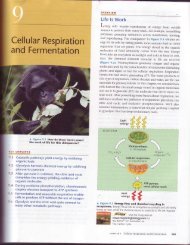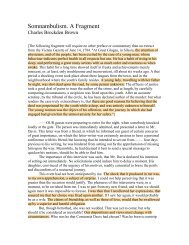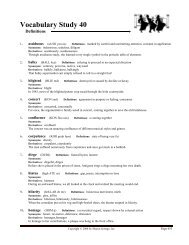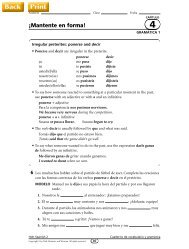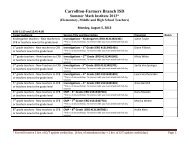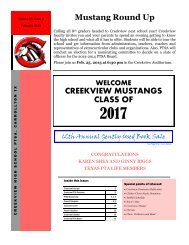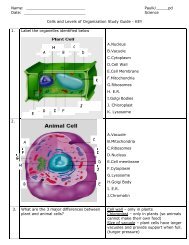Pt Two
Pt Two
Pt Two
You also want an ePaper? Increase the reach of your titles
YUMPU automatically turns print PDFs into web optimized ePapers that Google loves.
UNIT NINE: Neoclassicism STUDY GUIDE<br />
A Richard Boyle (Earl of Burlington) and William Kent. Chiswick House (near London, England), begun<br />
1725<br />
clear alternative to the splendors of Versailles/ Palladian classicism to create a “rational” look<br />
1. “In England, the Baroque- and especially Rococo, with all its frills – was rejected in the<br />
eighteenth century in favor of renewed interest in the ordered, classicizing appearance of<br />
Palladian architecture. Palladio‟s Four Books of Architecture was published in an English<br />
translation in 1715, and exerted widespread influence. An early example of English<br />
Palladian style is Chiswick House on the southwestern outskirts of London, which Lord<br />
Burlington (1695-1753) began in 1725 as a library and place for entertainments” (Adams,<br />
Art Across Time 691). “Lord Burlington was one of a powerful coterie of Whigs and<br />
supporters of the House of Hanover (George I and his family). He took a Grand Tour of<br />
Europe in 1714 to 1715 and returned to Italy in 1719 to revisit Palladio‟s buildings. On<br />
his return to England, he became an accomplished architect in the tradition of Palladio”<br />
(691). “Burlington based Chiswick House loosely on Palladio‟s Villa Rotonda, although it is on a<br />
smaller scale, and there are some significant differences in the plans. Unlike the Villa Rotonda,<br />
Chiswick House did not need four porticos. Instead, it has one, which is approached by lateral<br />
double staircases on each side. The arrangement of the rooms around a central octagon rather than<br />
a circle is also different, and the columns are Corinthian rather than Ionic as in the Villa Rotonda.<br />
There are no gable sculptures, and the roof is decorated on each side by a row of obelisks, which<br />
function as chimney flues. The dome is shallower than that of the Villa Rotonda, and rests on an<br />
octagonal drum, allowing more light into the central chamber” (692).<br />
2. “The building plan shares the geometrical symmetry of Palladio‟s villa, although its central core is octagonal rather than round and<br />
there are only two entrances. The main entrance, flanked now by matching staircases, is a Roman temple front, a flattering reference to<br />
the building‟s inhabitant. Chiswick‟s elevation is characteristically Palladian, with a main floor resting on a basement, and tall<br />
rectangular windows with triangular pediments. The result is a lucid evocation of Palladio‟s design, whose few but crisp details seem<br />
perfectly suited to the refined proportions of the whole. The popularity of the Palladian style among members of Burlington‟s class during<br />
the ensuing decades may be judged by the fact that Hogarth satirized the style in his Marriage a la Mode suite. The architect looking out<br />
the window in The Marriage Contract is probably a caricature of Burlington himself. In Rome, Burlington had persuaded an English<br />
expatriate, William Kent (1685-1748), to return to London as his collaborator. Kent designed Chiswick‟s surprisingly ornate interior as<br />
well as the grounds, the latter in a style that became known throughout Europe as the „English landscape garden.‟ Kent‟s garden, in<br />
contrast to the regularity and rigid formality of Baroque gardens, featured winding paths, a lake with a cascade, irregular plantings and<br />
shrubs, and other effects imitating the appearance of the natural rural landscape. The English landscape garden was another indication<br />
of the growing Enlightenment emphasis on the natural” (Stokstad, Art History 943).<br />
3. “Palladio appealed to the English partly because his designs for villas were well-suited to English country houses and partly because<br />
his style accorded with the Rule of Taste promoted by the Enlightenment philosopher Anthony Ashley Cooper, Third Earl of Shaftesbury.<br />
What distinguishes the Palladian revival from earlier classicisms, however, is less its external appearance than its motivation Instead of<br />
merely reasserting the superior authority of the ancients, it claimed to satisfy the demands of reason and thus to be more „natural‟ than<br />
the Baroque. At the time the Baroque style was identified with papist Rome by English Protestants, with absolutist France by George I,<br />
and with Tory policies by the Whig opposition. Thus began an association with between Neoclassicism and liberal politics that was to<br />
continue through the French Revolution. The appeal to reason found support in Palladio himself, who decried abuses „contrary to natural<br />
reason‟ on the grounds that „architecture, as well as all other arts, being an imitation of nature, can suffer nothing that either alienates or<br />
deviates from that which is agreeable to nature‟. This rationalism helps to explain the abstract, segmented look of Chiswick House on<br />
Burlington‟s estate. Adapted by Burlington and Kent from the Villa Rotonda, as well as other Italian sources, it is compact, simple, and<br />
geometric- the antithesis of the Baroque pomp of Blenheim Palace. The concept was not new to England. It had been used on a larger<br />
scale just a couple of years earlier at Mereworth castle by Campbell. Chiswick is at once bolder and more rigorous, yet less derivative<br />
than Mereworth. Campbell himself acknowledged Burlington as „not only a great Patron of all Arts, but the first Architect‟. The exterior<br />
surfaces are flat and unbroken, the ornament is meager, and the temple portico juts out abruptly from the blocklike body of the structure.<br />
The interior, probably by Kent, is more luxurious, in the manner of Jones, but with a clarity that looks forward to Robert Adam” (Janson<br />
650, 652).<br />
4. “In eighteenth-century Britain the majority of works of art and architecture, whether houses or gardens, paintings or sculptures, were<br />
created for a wealthy, predominantly English and aristocratic minority of the population. But those works express certain attitudes-<br />
above all the notion that sense of one‟s own grandeur or self-importance is something to be cautiously and carefully expressed- which<br />
were shared by the nation as a whole. Those same attitudes are present, albeit in a very different form, in the art that stood at the<br />
opposite end of the spectrum from the art of the aristocracy. The eighteenth century saw the beginnings of the British love and genius for<br />
satire: the ironizing and diminishing of the noble, the wealthy, the famous, which has remained a stock-in-trade of popular art and<br />
journalism for more than two centuries” (Graham-Dixon 94). “Following William Kent‟s lead, landscape architecture flourished in the<br />
hands of such designers as Lancelot (‘Capability’) Brown and Henry Flitcroft. In 1743, the banker Henry Hoare redid the grounds of<br />
his estate at Stourhead in Wiltshire with the assistance of Flitcroft, a protégé of Burlington. The resulting gardens at Stourhead carried<br />
William Kent‟s ideas much further. Stourhead is, in effect, an exposition of the picturesque, with orchestrated views dotted with Greek<br />
and Roman temples, grottoes, copies of antique statues, and such added delights as a rural cottage, a Chinese bridge, a Gothic spire, and<br />
a Turkish tent” (Stokstad, Art History 943).<br />
34



